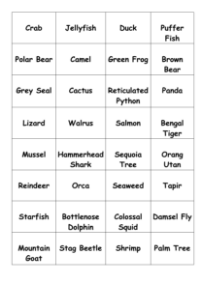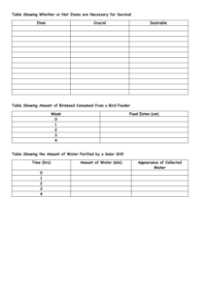Animal Survival - Habitats cards

Science Resource Description
The Aquatic habitat, encompassing rivers and lakes, is home to an array of flora and fauna. Among the plants thriving in these wet environments are Cattails and Water Lilies, which provide essential cover and food for various species. Wildlife such as Salmon, Crocodiles, and Frogs depend on these freshwater ecosystems for survival. In contrast, the Polar habitat is situated at the extreme northern and southern reaches of the globe, where conditions are vastly different. Hardy vegetation like Arctic Willow, Cottongrass, and Bearberry manage to survive the harsh climate. Iconic animals adapted to these icy realms include Polar bears, seals, and penguins, each uniquely suited to the cold.
Mountainous regions, found across the globe, support life in challenging altitudes where Grasses and Alpine Flowers bloom. The fauna here, like the Snow leopard, Ibex, and Condor, are acclimated to the rugged terrain and thin air. Grasslands, present on every continent except Antarctica, are dominated by Grasses, Milkweed, and a variety of Wildflowers, creating a habitat for animals such as Zebras, Capybaras, and Pronghorns. Meanwhile, Rainforests, located in tropical areas, are bursting with biodiversity, including the Rubber tree, Heliconia, and the Hanging Lobster Claw plant, as well as creatures like Tapirs, Gibbons, and Gorillas. The Marine habitat, encompassing the vast oceans, is the largest on Earth, with Seaweed, Kelp, and Algae supporting marine life such as Whales, Sharks, Turtles, Octopus, and numerous fish species. Forests, with cooler climates, are characterized by dense woodlands of Conifers, mosses, and ferns, and are inhabited by Wolves, Bears, and Deer. Lastly, Extreme habitats are places of intense heat, cold, or other challenging conditions where few can survive, yet life such as Tardigrades, Pompeii worms, and Yeti crabs find a way, alongside resilient plants like Kalanchoe and Cacti.









